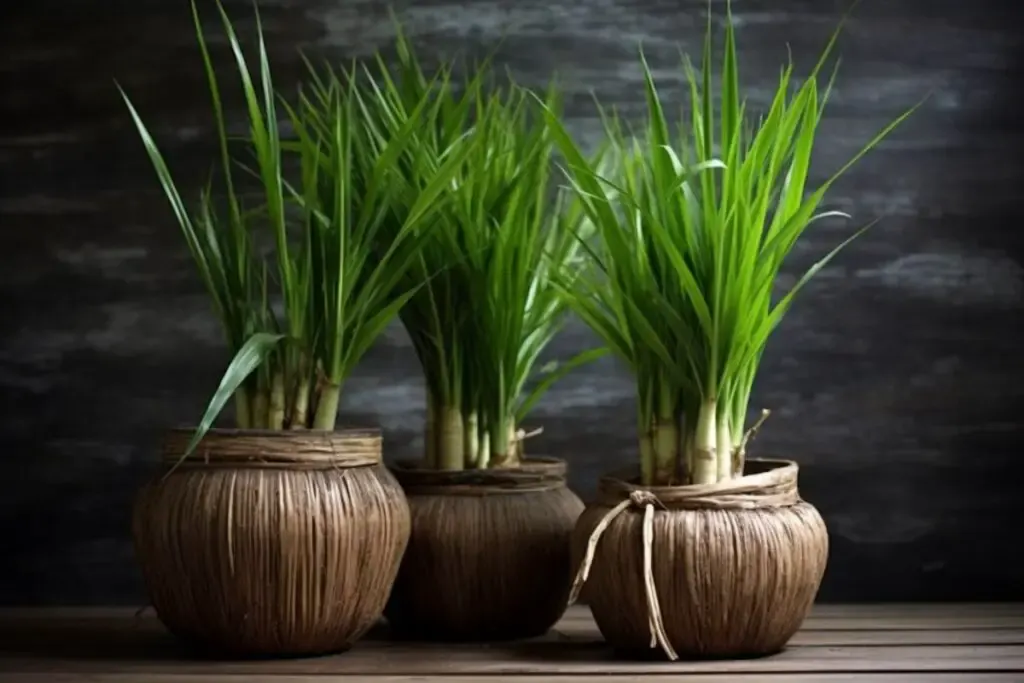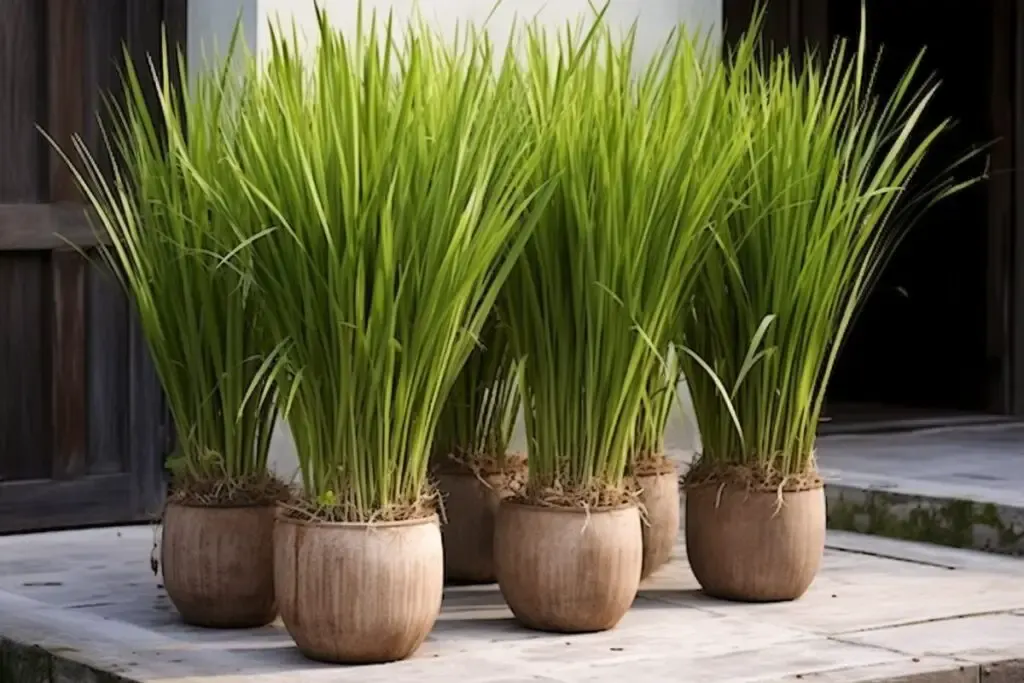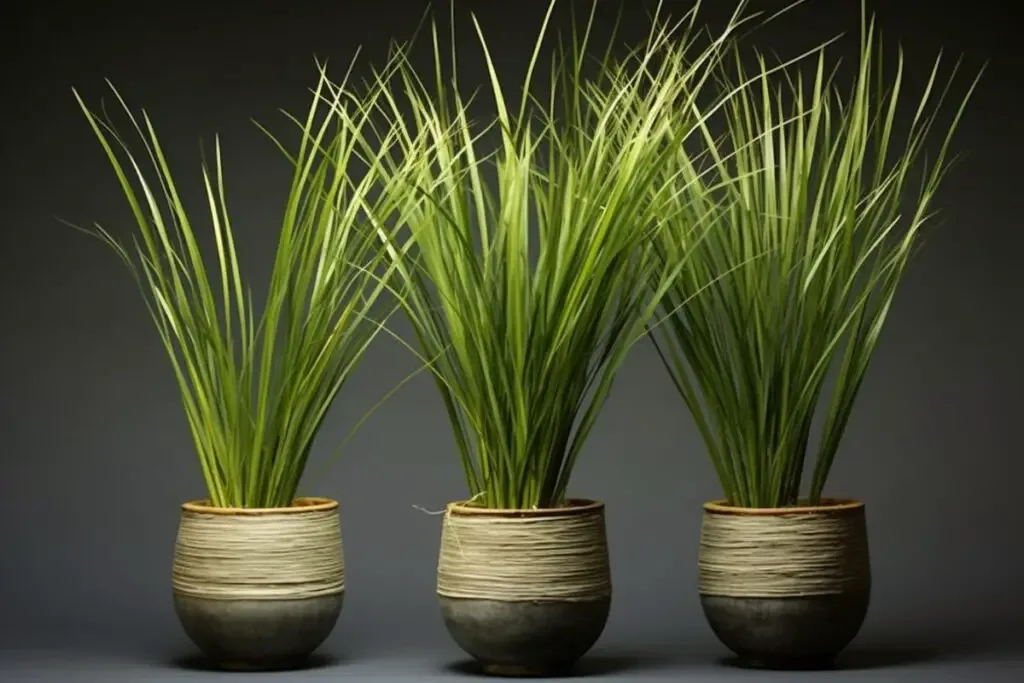If you’re looking to add a touch of the tropics to your patio or balcony garden, look no further than lemongrass. This fragrant herb not only offers a lemony zest to culinary dishes but also serves as an ornamental centerpiece and a natural pest repellent.
Growing lemongrass in pots is not only doable but also highly rewarding, and with a few expert tips, you can harvest your homegrown stalks right from your doorstep.
Does Lemongrass Grow Well in Pots?
Absolutely, lemongrass thrives in pots! Its adaptability makes it an excellent candidate for container gardening. When grown in pots, lemongrass plants can be easily managed and protected from harsh weather, and the pots can be moved to optimize sunlight exposure.
The key to successful lemongrass pot cultivation lies in choosing the right container, and soil mix, and providing adequate water and nutrients.
Potted lemongrass is ideal for small spaces and can add a lush, tropical look to your garden. It’s quite resilient, too—lemongrass doesn’t demand much attention once its basic needs are met.
Regular harvesting encourages the plant to become bushier, which means more lemongrass for your teas, soups, and stir-fries!
Best Lemongrass Varieties for Pots
While lemongrass is generally categorized into two main types—Cymbopogon citratus, which is more common for culinary uses, and Cymbopogon flexuosus, often used in the production of essential oils—there are a few varieties that particularly excel in pots.
1. East Indian Lemongrass (Cymbopogon flexuosus)

East Indian Lemongrass is your go-to if you’re interested in both the aromatic leaves for culinary use and essential oil extraction.
This variety is known for its vigorous growth and can reach heights of up to 3 feet in a pot, offering a substantial yield. It’s also quite hardy, with a resilience that makes it suitable for less experienced gardeners.
2. West Indian Lemongrass (Cymbopogon citratus)

A favorite among chefs, West Indian Lemongrass is celebrated for its potent flavor and scent. This variety grows a bit more compactly, making it perfect for pot cultivation.
Its stalks are thick and fleshy, which is exactly what you want for adding that zesty lemon flavor to your dishes.
3. Fever Grass (Cymbopogon nardus)

While ‘Fever Grass’ might not be as commonly known, it’s a hidden gem in the world of potted herbs. As its nickname suggests, it’s been historically used to reduce fevers and also as an insect repellent.
It’s a sturdy variety, less picky about conditions, and can be a beautiful ornamental grass with its thin, arching leaves. Growing lemongrass in pots is not just about the harvest; it’s about the joy of cultivating a plant that is both useful and decorative.
As with all potted plants, the key is to ensure they have enough space to grow, the right soil composition, and adequate water. Each variety of lemongrass brings its unique characteristics to the table, both in terms of growth habits and culinary uses.
How to Grow and Care For Lemongrass in Pots
Transforming your balcony or backyard into a lemongrass haven is easier than you might think.
With a bit of know-how and some consistent care, you can cultivate a bountiful lemongrass crop that’s both delicious and decorative.
Planting
Planting lemongrass in pots begins with selecting healthy, fresh stalks from your local garden center or grocery store. Look for greenish bases and avoid any that are brown or dry.
You can start your lemongrass from seed, but it’s far easier and quicker to start with a cutting. Simply place the stalks in water, and once they sprout roots—usually within a week or two—you can plant them in soil.
Pot Size
Lemongrass roots love room to expand, so choose a pot that’s at least 12 inches in diameter and has good depth to accommodate growth.
A larger pot not only gives the roots ample space but also holds more soil, which retains moisture better and provides more nutrients. Ensure the pot has adequate drainage holes to prevent waterlogged soil, which could lead to root rot.
Light
Lemongrass is a sun-lover, thriving best under full, direct sunlight. To ensure your potted lemongrass grows lush and flavorful, aim to give it at least six hours of sunlight daily.
This sun exposure is crucial for the plant to develop its signature lemony zest. If you live in a particularly hot climate, providing some afternoon shade can prevent the plant from getting too stressed.
My personal tip? Rotate the pot occasionally to ensure all sides of the plant receive equal sunlight, promoting even growth.
Soil
The right soil mix is a game-changer for growing healthy lemongrass in pots. You want a well-draining soil that’s rich in organic matter.
A blend of potting soil, compost, and a bit of sand or perlite works wonders. This mix not only provides the necessary nutrients but also ensures proper drainage, preventing the roots from sitting in water. Remember, while lemongrass loves moisture, it despises soggy feet!
Water
Watering your potted lemongrass correctly is critical for its growth. The soil should be kept consistently moist, but not waterlogged. I usually water my lemongrass when the top inch of the soil feels dry to the touch.
In hotter months, this might mean watering every day, while in cooler seasons, the frequency may decrease. Always check the soil before watering, and ensure your pot has good drainage to avoid any risk of root rot. Regular, attentive watering will yield a robust and aromatic lemongrass plant.
Temperature and Humidity
Lemongrass is a lover of warm climates and does best in temperatures between 65°F and 85°F (18°C to 29°C).
It can tolerate a bit of humidity, which is often a byproduct of its preferred warm environments. If you’re growing lemongrass in a cooler climate, bring the pots indoors when the temperature drops below 50°F (10°C).
Fertilizer
While lemongrass isn’t particularly demanding, feeding it can help promote lush growth. Use a balanced, liquid fertilizer once a month during the growing season.
Organic options such as fish emulsion or compost tea are excellent choices and can be used more frequently, as they’re gentle on the plants and provide a rich array of nutrients.
Pruning Potted Lemongrass
To keep your lemongrass looking its best and encourage more growth, regular pruning is essential. This process helps prevent the plant from becoming too woody and sparse.
Ideally, you want to harvest the lemongrass when the stalks are about a half-inch thick and the plant is at least 12 inches tall. Cut the stalks at the base with clean, sharp scissors or gardening shears, which will stimulate new growth.
You can also trim any brown or dead leaves that may appear to keep your plant healthy and attractive. Regular harvesting is a form of pruning that not only gives you fresh herbs for your culinary uses but also keeps the plant vigorous and bushy.
Overwintering
Lemongrass is a tropical plant that doesn’t fare well in cold temperatures. If you live in an area where the temperature drops below 50°F (10°C), you’ll need to overwinter your plant.
Before the first frost, bring your lemongrass pots indoors to a sunny spot—preferably a south-facing window—where they can continue to grow slowly throughout the winter.
If indoor space is limited, you can trim the lemongrass down to a few inches above the soil and store it in a cool, dark place like a basement or garage, as long as it doesn’t freeze. Water it sparingly, just enough to keep the soil from drying out completely.
As the days lengthen and temperatures rise in early spring, begin to water more frequently and reintroduce the plant to more sunlight to wake it up from dormancy. By the time the threat of frost has passed, your lemongrass will be ready to move back outdoors for another season of growth.
In both pruning and overwintering, the goal is to maintain the vitality of the lemongrass so that when it returns to the outdoors, it will flourish. With these care tips, your lemongrass can grow as a perennial, providing fragrant leaves and stalks year after year.

